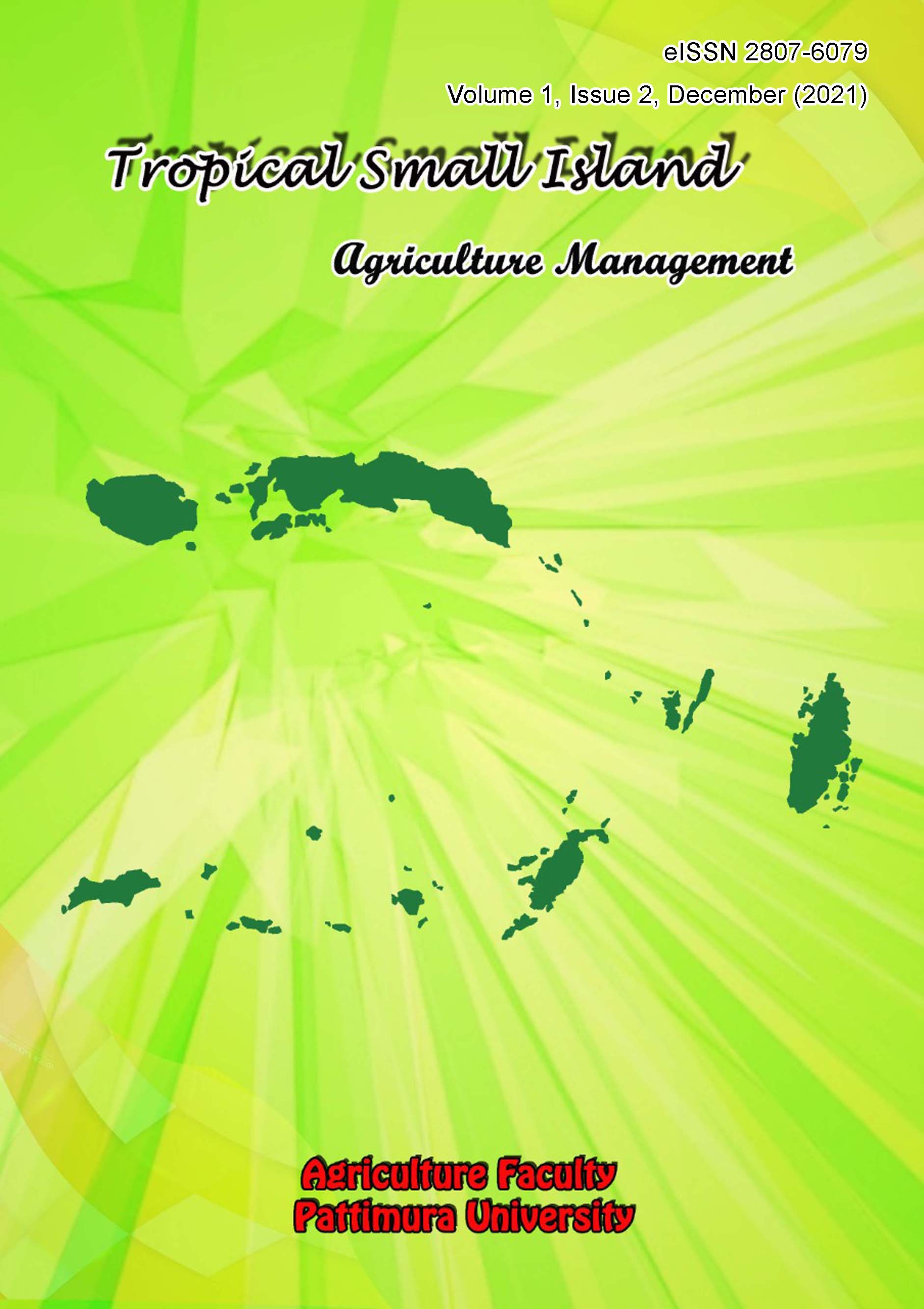Klasifikasi Gulma Pada Areal Kebun Praktikum Fakultas Pertanian Universitas Pattimura Ambon
Classification of Weed of Garden Areas Practicum Faculty of Agriculture Pattimura Ambon University
Abstract
At the location of the former garden in the faculty of agriculture area, various types of weeds were found growing side by side and forming a weed community. The area used to be a former demonstration garden area owned by the faculty of agriculture which was used by students as a practicum area for planting vegetable crops such as kale, mustard greens, spinach and long beans using fertilizer derived from chicken manure and cow dung. After harvesting and left empty, the land grows various types of weeds that coexist in the area. This study aims to describe the various types of weeds in the garden at the faculty of agriculture and find the dominant weed species in the garden at the faculty of agriculture. This study used a vegetation survey method with a 1 m × 1 m kudran. The results showed that 46 types of weeds were found in the former Agriculture faculty garden area with 26 types of dominant weeds and weeds with the highest SDR value in Mimossa pudica weed.
Downloads
References
Hamid, I. (2010). Indentifikasi pada areal pertanaman cengkeh (Eugenia aromatica) di Desa Nalbessy Kecamatan Leksula Kabupaten Buru Selatan. Agrikan: Jurnal Agribisnis Perikanan, 3(1), 62-71.
Herbie, T. (2015). Kitab Tanaman Berkhasiat Obat-226 Tumbuhan Obat untuk Penyembuhan Penyakit dan Kebugaran Tubuh. Yogyakarta: Octopus Publishing House. 359 hal.
Hgairtety, D.A., Riry, J., & Tanasale, V.L. (2017). Studi komunitas gulma di areal pertanaman cengkeh (Syzygium aromaticum L.) tanaman menghasilkan pada ketinggian tempat yang berbeda di Negeri Hatu Kecamatan Leihitu Barat Kabupaten Maluku Tengah. Jurnal Budidaya Pertanian, 13(2), 78-83.
Imaniasita, V., Liana, T., & Pamungkas, D.S. (2020). Identifikasi keragaman dan dominansi gulma pada lahan pertanaman kedelai. Agrotechnology Research Journal, 4(1), 11–16. https://doi.org/10.20961/agrotechresj.v4i1.364 49
Inayati. (2015). Efektivitas gel ekstrak daun putri malu (Mimosa pudica Linn) sebagai hand sanitizer. Laporan Penelitian. Universitas Muhammadiyah Yogyakarta, Yogyakarta.
Makaruku, M.H., Tanasale, V.L., & Goo, N. (2022). Karakteristik vegetasi gulma pada pertanaman cengkeh di Negeri Hatu Kecamatan Leihitu Barat, Kabupaten Maluku Tengah. Jurnal Ilmu Pertanian, 1(1), 43-51.
Noor, A. & Ningsih, R.D. (1998). Upaya meningkatkan kesuburan dan produktivitas tanah di lahan kering dalam prosiding lokakarya strategi pembangunan pertanian wilayah Kalimantan. Jurnal Penelitian dan Pengkajian Teknologi Pertanian, 14(2), 57-67.
Prayogo, D.P., Sebayang, H.T., & Nugroho, A. (2017). Pengaruh pengendalian gulma pada pertumbuhan dan hasil tanaman kedelai (Glycine Max L.). Jurnal Produksi Tanaman, 5(1), 24-32.
Syahid, M.A.N., Utari, CR. S., Djumarga, S. (2011). Pengaruh ekstrak putri malu (Mimosa pudica) terhadap mortalitas Ascaris suum secara in vitro. Biofarmasi, 9(2), 33-37.
Tanasale, V. (2010). Komunitas Gulma Pada Pertanaman Gandaria Belum Menghasilkan dan menghasilkan Pada Ketinggian Tempat Yang Berbeda. (Tesis) UGM, Yogyakarta.
Tanasale, V.L., Marasabessy, D.A., & Goo, N. (2020). Inventarisasi jenis gulma di areal pertanaman cengkeh (Syygium aromaticum L.) di Negeri Allang Kecamatan Leihitu Barat Kabupaten Maluku Tengah. Jurnal Agroteknologi dan Agrbisnis, 4(2), 29–39. https://doi.org/10. 51852/jaa.v4i2.435.
Tjitrosoedirdjo, S., Utomo, I.H., & Wiroatmodjo, J. (1984). Penggelolaan Gulma di Perkebunan. PT Gramedia: Jakarta.
Waterhouse, B.M. & Mitchell, A.A. (1998). Northern Australia Quarantine Strategy: Weeds target list, second edition, Australian Quarantine and Inspection Service, Misc. Pub., Australia, 29-30.
Copyright (c) 2023 The Author(s)

This work is licensed under a Creative Commons Attribution-ShareAlike 4.0 International License.
Authors who publish with this journal agree to the following terms:
- Authors retain copyright and grant the journal right of first publication with the work simultaneously licensed under a Creative Commons Attribution License that allows others to share the work with an acknowledgment of the work's authorship and initial publication in this journal.
- Authors are able to enter into separate, additional contractual arrangements for the non-exclusive distribution of the journal's published version of the work (e.g., post it to an institutional repository or publish it in a book), with an acknowledgment of its initial publication in this journal.
- Authors are permitted and encouraged to post their work online (e.g., in institutional repositories or on their website) prior to and during the submission process, as it can lead to productive exchanges, as well as earlier and greater citation of published work (See The Effect of Open Access).









